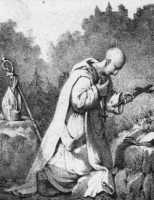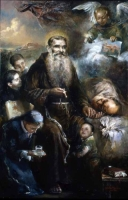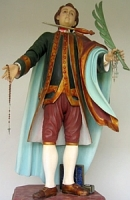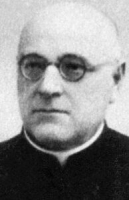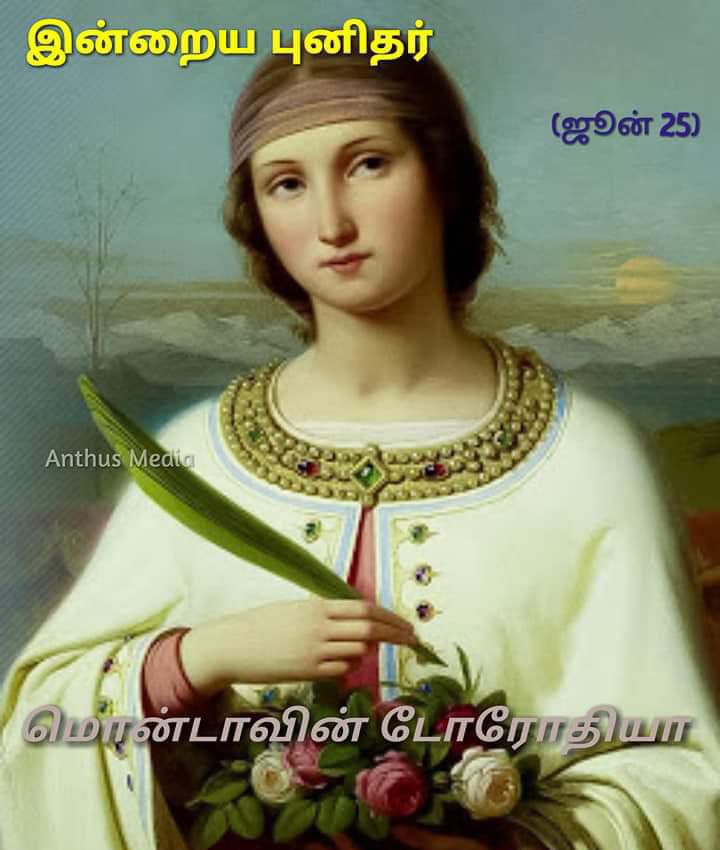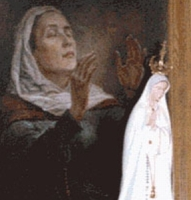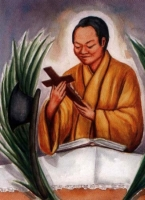St. Marie Magdalen Fontaine
Feastday: June 26
Death: 1794
Martyred Sister of Charity of St. Vincent de Paul. She was superior of the congregation's house at Arras when the French Revolution erupted in the country With three members of her community, Mary Magdalen was guillotined at Cambrai, France. She was beatified in 1920.
Bl. Jane Gerald
Feastday: June 26
Death: 1794
Nun and martyr. A member of the Sisters of Charity of Arras, France, she was arrested in 1792 by officials of the French revolutionary government and guillotined at Cambrai.
Bl. Teresa Fantou
அருளாளர் தெரசா ஃபேன்டோ (1747-1794)
இவர் பிரான்ஸ் நாட்டில் பிறந்தவர்.
இவரை இவரது தாயார் சிறுவயதிலிருந்தே இறைநம்பிக்கையில் வளர்த்து வந்தார். இதனால் இவர் தனது இருபத்தைந்தாவது வயதில், புனித வின்சென்ட் தெ பவுலைப் பாதுகாவலராகக் கொண்ட அன்பின் பணியாளர்கள் சபையில் சேர்ந்து பணி செய்ய தொடங்கினார்.
இவர் தன்னுடைய சபை அருள்சகோதரிகளோடு சேர்ந்து, நோயாளர்களைக் கவனித்துக் கொள்வதும், இல்லங்களைச் சந்திப்பதும், குழந்தைகளுக்குக் கல்வி கற்றுக் கொடுப்பதுமாக இருந்தார்.
இப்படிப்பட்ட சூழ்நிலையில்தான் பிரான்ஸ் நாட்டில் புரட்சி வெடித்தது. இப்புரட்சி திருஅவைக்கு மிகப்பெரிய அச்சுறுத்தலாக இருந்தது. குறிப்பாக, கிறிஸ்தவர்கள் உரோமைக்குப் பணிந்து நடப்பதை விடுத்து பிரான்ஸ் நாட்டின் அதிகாரத்திற்கு பணிந்து நடக்கக் கேட்டுக்கொள்ளப்பட்டார்கள்.
இதற்கு இவரும் இவருடைய சபை அருள்சகோதரிகள் மூவரும் Sisters Marie-Madeleine Fontaine, Marie-Françoise Lanel, Thérèse Fantou, and Jeanne Gérard மறுப்பு தெரிவித்ததால், கலகக்காரர்கள் இவர்களைத் தலை வெட்டிக் கொன்று போட்டார்கள்.
இவருக்கும் இவரோடு இறந்த அருள்சகோதரிகளுக்கும் 1920ஆம் ஆண்டு திருத்தந்தை பதினைந்தாம் பெனடிக்ட் அருளாளர் பட்டம் கொடுத்தார்
Born 29 July 1747
Miniac-Morvan, Kingdom of France
Feastday: June 26
Death: 1794
French martyr. A member of the Sisters of Charity in Arras, during the French Revolution, she was arrested by republican authorities and guillotined at Cambrai.Teresa and her three companions, Francoise Lanel, Madeleine Fontaine, and Joan Gerard were beatified in 1920.
Blessed Andrea Giacinto Longhin
Also known as
• Andrea of Fiumicello
• Andrew Longhin
• Andrew of Campodarsego
• Bishop of the Catechism
• Hyacinth Bonaventure Longhin
Profile
The only son of Matthew and Judith Marin, poor and pious tenant farmers. He early felt a call to the priesthood. Against the wishes of his father, he became a Capuchin novice, taking the name Andrew of Campodarsego at Bassano del Grappa, Venice on 27 August 1879 at age 16. He studied at Padua and Venice in Italy, made his solemn profession on 4 October 1883, and was ordained on 19 June 1886.
Spiritual director for young religious for 18 years. Taught at the Capuchin seminary at Udine, Italy. Director of Capuchin teachers at Padua in 1889. Director of theology students in Venice in 1891. Capuchin Provincial Minister at Venice on 18 April 1902 where he came to the attention of the future Pope Saint Pius X. Bishop of Treviso, Italy, consecrated in Rome, Italy on 17 April 1904, a see he would hold for 32 years.
He entered the see with reform in mind, and spent five years travelling from parish to parish, preaching and becoming close to his parishioners and clergy, many of whom resisted his reforming efforts. He reformed the diocesan seminary, improving the quality of teaching and spiritual formation. He promoted spiritual retreats for the clergy, and worked with lay groups, especially those involved in the Catholic social movement, supporting the right for workers to organize. He encouraged religious orders to work in his diocese; male institutes went from 7 to 12, women's from 10 to 24 during his bishopric, and these included houses of Franciscans, Passionists, Salesians, Carmelites, Somaschi Fathers, Camillians, and Missionary Oblates of Mary Immaculate. Friend of Saint Leopold Mandic.
During the air and ground attacks that destroyed Treviso in World War I, Bishop Andrew stayed at his post, and told his priests that they could leave if they were ministering to refugees. Andrew became the center of work in the community, organizing help for soldiers, the wounded, the sick and the poor. Because he refused to ally himself with any of the war parties, he was convicted of defeatism, and was imprisoned with several of his priests. Upon his release, he resumed his work of ministering in his diocese, and rebuilding the city and the 47 parishes that had been destroyed, and was eventually awarded the Cross of Merit war decoration.
During the post-war years, Bishop Andrew worked with many lay groups to help keep the Catholic social movement as Catholic as possible. He insisted on non-violence and loyalty to the Church, which put him at odds with the growing Fascist movement. In 1920 he supported Leghe Bianche, a Christian union movement. Pope Pius X chose him as Apostolic Visitor to Padua in 1923 and then Udine in 1927 to 1928 in order to return unity between the priests and bishops of those dioceses.
Born
22 November 1863 in Fiumicello di Campodarsego, province and diocese of Padua, Italy as Hyacinth Bonaventure Longhin
Died
• Friday 26 June 1936 in Treviso, Italy of natural causes following an eight-month illness
• interred in the cathedral of Treviso
Beatified
• 10:00 am Sunday 20 October 2002 by Pope John Paul II
• his Cause began on 21 April 1964
• his beatification miracle involved the 1964 cure of Dino Stella from diffuse peritonitis
Saint Josemaria Escriva
புனிதர் ஜோஸ்மரியா எஸ்கிரிவா
குரு, சாதாரண நிலைவாழ்வின் புனிதர்:
பிறப்பு: ஜனவரி 9, 1902
பார்பஸ்ட்ரோ, அரகன், ஸ்பெயின்
இறப்பு: ஜூன் 26, 1975 (வயது 73)
ரோம், இத்தாலி
ஏற்கும் சமயம்:
ரோமன் கத்தோலிக்க திருச்சபை
அருளாளர் பட்டம்: மே 17, 1992
திருத்தந்தை இரண்டாம் ஜான் பவுல்
புனிதர் பட்டம்: அக்டோபர் 6, 2002
திருத்தந்தை இரண்டாம் ஜான் பவுல்
முக்கிய திருத்தலங்கள்:
அமைதியின் அன்னை, ஓபஸ் தேயி-யின் தலைமை ஆலயம், ரோம்
நினைவுத் திருவிழா: ஜூன் 26
“புனிதர் ஜோஸ்மரிய எஸ்கிரிவா டி பலகுயர் ஒய் அல்பஸ்”, (Saint Josemaría Escrivá de Balaguer y Albás) “ஓபஸ் தேயி” (Opus Dei) (ஆங்கிலம்: கடவுளின் பணி) (English: Work of God) என்னும் பொது நிலையினருக்கான கத்தோலிக்க நிறுவனமொன்றினை நிறுவிய ஸ்பெயின் (Spain) நாட்டின் ரோமன் கத்தோலிக்க குரு ஆவார். “ஓபஸ் தேயி” (Opus Dei), நாம் அனைவருமே தூய வாழ்க்கை வாழ்வதற்கு அழைக்கப்பட்டிருக்கிறோம் என்றும், சாதாரண வாழ்க்கை புனிதத்துவத்திற்கு ஒரு பாதை என்றும் கற்பிக்கிறது. குறிப்பிட்ட உறுப்பினர்களால் தேர்வு செய்யப்பட்டு, திருத்தந்தையால் நியமனம் செய்யப்படும் கத்தோலிக்க குருவின் ஆட்சியின் கீழுள்ள இந்நிறுவனத்தின் பெரும்பான்மை உறுப்பினர்கள் பொதுநிலையினரும் மதச் சார்பற்ற குருக்களுமேயாவர்.
2002ம் ஆண்டில் இவருக்கு புனிதர் பட்டம் அளித்த திருத்தந்தை இரண்டாம் ஜான் பவுல், “புனிதர் ஜோஸ்மரிய எஸ்கிரிவா கிறிஸ்தவத்திற்கு சாட்சியம் பகர்ந்த தலையானவர்களுள் ஒருவர்" என்றார்.
இவர், ஸ்பெயின் நாட்டின் தலைநகரான “மேட்ரிட்’டிலுள்ள” “கம்ப்லுயுடென்ஸ் பல்கலைக்கழகத்தில்” (Complutense University of Madrid) சிவில் சட்டமும் (Civil Law), ரோம் (Rome) நகரிலுள்ள “லடெரன் பல்கலைக்கழகத்தில்” (Lateran University) இறையியலில் (Doctorate in Theology) முனைவர் பட்டங்களும் வென்றார்.
43 மொழிகளில் மொழிபெயர்க்கப்பட்ட, (The Way) என்னும் பெயரில் இவர் எழுதி வெளியான இவரது புத்தகம், பல இலட்சம் பிரதிகள் விற்பனையாயின.
ஜோஸ்மரிய எஸ்கிரிவா மீதும் இவரது நிறுவனமான “ஓபஸ் தேயி” மீதும் சர்ச்சைகளும் – முதன்மையாக, இரகசியங்கள் தொடர்பான குற்றச்சாட்டுக்களும் எழுந்தன. உயர்தரம், வழிபாட்டு முறை, ஸ்பெயின் நாட்டில் ஜெனரல் பிராங்கோவின் சர்வாதிகாரம் (Dictatorship of General Franco) போன்ற வலதுசாரி காரணங்களுடன் அரசியல் ஈடுபாடுகளும் சரிச்சைகளில் சிக்கின.
மரணத்துக்குப் பிந்தைய இவரது புனிதர் பட்டத்துக்கான தயாரிப்புகள், சில கத்தோலிக்கர்களாலும் உலகளாவிய பத்திரிக்கையாளர்களாலும் கணிசமான கவனத்தையும் சர்ச்சைகளையும் ஈர்த்தது. “ஓபஸ் டேய்” (Opus Dei) (ஆங்கிலம்: கடவுளின் பணி) (English: Work of God) சம்பந்தமான சரித்திரம் பற்றின புலன் விசாரணைகளில், வாட்டிகனின் “ஜான் எல். ஆலன், ஜூனியர்” (John L. Allen, Jr) உள்ளிட்ட பல்வேறு உலகளாவிய பத்திரிக்கையாளர்கள் ஈடுபட்டனர். பல குற்றச்சாட்டுக்கள் நிரூபிக்கப்படவில்லை என்றும், அவை ஜோஸ்மரிய எஸ்கிரிவா மற்றும் அவரது நிறுவனங்களின் எதிரிகளால் உருவாக்கப்பட்டவை என்றும் கூறப்பட்டன.
ஆரம்ப வாழ்க்கை:
“ஜோஸ் மரிய மரியானோ எஸ்க்ரிவா ஒய் அல்பாஸ்” (José María Mariano Escrivá y Albás) எனும் இயற்பெயர் கொண்ட இவர், ஸ்பெயின் (Spain) நாட்டின் சிறு நகரான “பர்பஸ்ட்ரோவில்” (Barbastro) பிறந்தவர் ஆவார். இப்புனிதரது தந்தை “ஜோஸ் எஸ்கிரிவா ஒய் கொர்ஸன்” (José Escrivá y Corzán) ஆவார். இவரது தாயாரின் பெயர், “மரிய டி லாஸ்” (María de los Dolores Albás y Blanc) ஆகும். இவர், தமது பெற்றோரின் ஆறு குழந்தைகளில் இரண்டாவதாகப் பிறந்தவர் ஆவார். வியாபாரியும் ஜவுளி நிறுவனமொன்றில் பங்குதாரராகவுமிருந்த இவரது தந்தை வியாபாரத்தில் நஷ்டப்பட்டு, திவாலாகிப் போனார். அதன் காரணமாக, 1915ம் ஆண்டு “லோக்ரோனோ” (Logrono) நகருக்கு குடும்பத்தை அழைத்துச் சென்ற தந்தை, அங்கே ஒரு ஆடைகள் கடையில் எழுத்தராக பணியாற்றினார்.
உறைபனியில் வெறும் கால்களுடன் நடந்து சென்ற துறவியொருவரின் காலடித் தடங்கள், தம்மை ஏதோவொன்றுக்கு தேர்வு செய்திருப்பதாக இவரை உணர வைத்தது. தமது தந்தையில் பரிபூரண ஆசியுடன், கத்தோலிக்க திருச்சபையின் குருவாகும் தயாரிப்பில் ஈடுபட்டார். 1924ம் ஆண்டு, டிசம்பர் மாதம், 20ம் தேதியன்று, “சரகோசா” (Zaragoza) நகரில் திருத்தொண்டராக அருட்பொழிவு செய்விக்கப்பட்டார். 1925ம் ஆண்டு, மார்ச் மாதம், 28ம் நாளன்று, அதே நகரில் குருத்துவ அருட்பொழிவு செய்விக்கப்பட்டார்.
செபமும் தியானமும், கடவுளுடைய சித்தமாக அவர் கருதினவற்றை இன்னும் தெளிவாக புரிந்துகொள்ள அவருக்கு உதவியது. 1928ம் ஆண்டு, அக்டோபர் மாதம், 2ம் நாளன்று, கத்தோலிக்கர்கள் தங்களின் மதச்சார்பற்ற பணிகளில் தங்களைப் பரிசுத்தப்படுத்திக்கொள்ள “ஓபஸ் டேய்” (Opus Dei) (ஆங்கிலம்: கடவுளின் பணி) (English: Work of God), ஒரு வழி என்பதனைக் கண்டுணர்ந்தார். 1928ம் ஆண்டு “ஓபஸ் டேய்” (Opus Dei) நிறுவப்பட்டது. 1950ம் ஆண்டு, திருத்தந்தை பன்னிரெண்டாம் பயஸ் (Pope Pius XII) அதற்கு இறுதி அங்கீகாரம் வழங்கினார்.
ஜோஸ்மரிய எஸ்கிரிவா, 1975ம் ஆண்டு, ஜூன் மாதம், 26ம் நாளன்று, தமது 73 வயதில் மரித்தார்
Also known as
Josemaria Escriva de Balaguer
Profile
One of six children born to Jose and Dolores Escriva; three of his siblings died in infancy. His father was a small businessman, and when his business failed in 1915, the family moved to Logroño, Spain. As a young man, Josemaria saw the bare footprints left in the snow by a monk; the sight moved him, and kindled a desire for religious vocation. He studied for the priesthood in Logroño and Zaragoza, Spain. His father died in 1924, and Josemaria had to simultaneously support the family while studying. Ordained in Zaragoza on 28 March 1925.
Assigned for a while to a rural parish, and then in Zaragoza. Moved to Madrid, Spain in 1927 to study law. Following a profound spiritual retreat, Josemaria founded Opus Dei in Madrid on 2 October 1928, opening a new way for the faithful to sanctify themselves in the midst of the world through their work and fulfillment of their personal, family and social duties. The next few years were spent studying at the University of Madrid, teaching to support his mother and siblings, ministering to the poor and sick, and working to build the foundation of Opus Dei.
Religious persecution in the Spanish Civil War forced Josemaria into hiding, and he ministered covertly to his parishioners. He escaped across the Pyrenees to Burgos, Spain. At the end of the war in 1939, he returned to his studies in Madrid. Doctor of law. Retreat master for laity, priests, and religious.
On 14 February 1943 he founded the Priestly Society of the Holy Cross, united to Opus Dei. Josemaria moved to Rome, Italy in 1946, and earned a doctorate in theology from the Lateran University. Consultor to two Vatican Congregations. Honorary member of the Pontifical Academy of Theology. Named a prelate of honor by Pope Pius XII.
Opus Dei received the approval of the Holy See on 16 June 1950. Josemaria travelled frequently throughout Europe and Latin America to work for the growth of Opus Dei, and by the time of his death, it had spread to five continents with over 60,000 members of 80 nationalities, and today has over 80,000 members, most laymen.
Born
9 January 1902 at Barbastro, Spain
Died
• 26 June 1975 of natural causes in his office in Rome, Italy
• interred at Prelatic Church of Our Lady of Peace at Viale Bruno Buozzi 75, Rome, Italy
Beatified
• 17 May 1992 by Pope John Paul II
• the beatification miracle involved the cure in 1976 of Carmelite Sister Concepcion Boullon Rubio from the nearly-fatal cancerous form of lipomatosis following prayers by her family for the intercession of Father Josemaria
Canonized
• 6 October 2002 by Pope John Paul II
• the canonization miracle involved saving a surgeon's hands from a career-ending disease
Saint José María Robles Hurtado
Additional Memorial
21 May as one of the Martyrs of the Mexican Revolution
Profile
Born to a fervently Catholic family, the son of Antonio Robles and Petronila Hurtado. Entered the seminary of Guadalajara, Mexico at age 12. Ordained on 22 March 1913 at age 25 at Guadalajara.
Consecrated to the Sacred Eucharistic Heart of Jesus, and in 1918 founded the Congregation of Victims of the Eucharistic Heart of Jesus (Hermanas del Corazón de Jesús Sacramentado) at Nochistlan, Zacatecas, Mexico. The congregation was dedicated to pastoral health and education, assisting orphanages, and conducting missions. Today it is known as the Sisters of the Sacred Heart of Jesus.
Parish priest in Tocolotlan in 1920. During the persecutions of the Mexican Revolution, priests were outlawed; parishioners urged Father Jose to run, but he could not abandon his people. He was arrested on 25 June 1927 for presiding at Mass in private homes; he was at a make-shift altar when soldiers broke in to grab him. Hanged from an oak tree the next day, after having blessed and forgiven his captors; he kissed and blessed the rope, and put around his own neck so no executioners would not be guilty of the murder. One of the Martyrs of the Cristera War.
Born
3 May 1888 at Mascota, Jalisco, Mexico
Died
• hanged on 26 June 1927 at Quila, Jalisco, Mexico
• relics at the church at Tecolotlan
Canonized
21 May 2000 by Pope John Paul II during the Jubilee of Mexico
Blessed Giuseppina Catanea
Also known as
• Pinella (childhood nickname in her family)
• Sister Maria Giuseppina of Jesus Crucified
• Marie-Joséphine de Jésus crucifié
Profile
Born to the Italian nobility, Giuseppina was known as a pious girl with great care for the poor, a devotion to Mary and the Eucharist, and for praying her rosary whenever she had a chance. She developed the heart condition angina pectoris in 1912, later contracted spinal tuberculosis, and was eventually confined to a wheelchair. Against her family’s objections, she joined the Carmelites on 10 March 1918. Following a pair of visions of Saint Francis Xavier, Giuseppina was miraculously cured on 26 June 1922; word leaked out and people from all over the region came to learn from her. In 1932 she received approval from Pope Pius XI to found a cloistered house of Discalced Carmelites; she took the name Sister Maria Giuseppina of Jesus Crucified and made her solemn profession on 6 August 1932. Sub-prioress in 1934. In 1943 she developed multiple sclerosis, began to lose her sight, and in 1944 was again confined to a wheelchair. As intructed by her spiritual director, she began writing an autobiography and spiritual journal for the benefit of the sisters who might learn from her. Chosen vicar in early 1945, and then prioress on 29 September 1945, a position she held the rest of her life.
Born
18 February 1894 in Italy
Died
14 March 1948 in Naples, Italy of natural causes
Beatified
• 1 June 2008 by Pope Benedict XVI
• beatification recognition celebrated at the Cathedral in Naples, Italy presided by Cardinal Crescenzio Sepe
Saint Vigilius of Trent
புனித.விஜிலியஸ்
ஆயர், மறைசாட்சி
பிறப்பு
353
இறப்பு
405
இவர் தனது இளம் வயது கல்வியை உரோம் நகரில் பயின்றார். பின்பு தனது 20 ஆம் வயதில் தனது குடும்பத்தை விட்டு பிரிந்து ஏதென்ஸ்(Athen) நகருக்கு சென்றார். அங்கு மிக கடுமையான, ஏழ்மையான வாழ்வை வாழ்ந்தார். இவரின் வாழ்வு, பார்த்தவர்களை பரவசமடைய செய்தது. இவர் ஏழ்மையின் இளைஞர் என்று பெயர் பெற்றார். பிறகு குருமடத்தில் சேர்ந்து குருவானார். அப்போது 384 ஆம் ஆண்டு டிரிண்டைன்(Trient) ஆயர் இறந்து போகவே விஜிலியஸ் டிரிண்டைன் ஆயராக திருநிலைப்படுத்தப்பட்டார். இவர் ஆயர் பொறுப்பில் இருக்கும்போது, தன் மறைமாவட்டத்தில் எண்ணிலடங்கா ஆலயங்களை எழுப்பினார். பின்னர் அவ்வாலயங்களில் விசுவாசிகளை நிரப்ப, மறைமாவட்டம் முழுவதும் கால்நடையாகவே சென்று நற்செய்தியை பறைசாற்றினார். அவ்வாறு மலைப்பகுதியில் சென்று நற்செய்தி போதிக்க சென்றபோது, மலையிலிருந்து ஒரு பெரிய கல் அவரின் மீது விழவே, அதே இடத்திலேயே உயிர் துறந்தார்.
செபம்:
நற்செய்திக்கு சான்று பகரவே வந்தேன் என்று மொழிந்த இறைவா! நற்செய்தியின் மீது கொண்ட தாகத்தாலும், உம்மீது கொண்ட அன்பாலும் புனித விஜிலியஸ் தன் உயிரை நீத்தார். நாங்களும் நற்செய்தியின் மீது ஆர்வம் கொண்டு, வார்த்தைகளை வாழ்வாக்கி வாழ்ந்திட இறைவா உம் வரம் தாரும்.
Also known as
Vigilio
Profile
Roman patrician, son of Theodosius and Maxentia. Brother of Saint Claudian and Saint Magorian. Studied at Athens, Greece where he developed a reputation for learning and sanctity. Friend of Saint John Chrysostom. Settled in the region of Trent, Italy in 380. Chosen bishop of Trent by the faithful of the area. Worked to help the poor, and opposed usury. Friend of Saint Ambrose of Milan. Nearly ended paganism in his diocese, and worked to bring Arians back to orthodox Christianity. Missionary to the areas surrounding his diocese, founding 30 parishes. Worked with Saint Sisinnius, Saint Martyrius and Saint Alexander about whom he wrote De Martyrio SS. Sisinnii, Martyrii et Alexandri. Killed when he overturned a statue of Saturn in the one the few remaining enclaves of such pagan worship. Pope Benedict XIV called Vigilius the first martyr canonized by a pope.
Born
c.353
Died
• stoned to death on 26 June 405 near Lake Garda in the Val di Rendena
• buried in Trent, Italy
Patronage
• diocese of Bolzano-Bressanone, Italy
• Trent, Italy
• Tyrol, Italy
Representation
bishop holding a shoe
Saint Anthelm of Belley
Also known as
• Anthelm de Chignin
• Anthelme, Anthelmus
Profile
Born to the nobility. Priest. Provost of a cathedral chapter. He got caught up in Church politics, and sought ecclesiastical positions to increase his power and authority rather than ability to serve. A visit to the Carthusians at Portes changed his view of his vocation, and he felt drawn to the monastic life. At age thirty, Anthelm renounced his offices, and retired to the Carthusian monastery. Within two years he was prior of the mother house at Grande Chartreuse; the monastery flourished and increased in both numbers and holiness. During the Schism of 1158 he supported Pope Alexander II, earning him the enmity of Emperor Frederick Barbarossa. Bishop of Belley, France; he was so beloved that the town was briefly known as Anthelmopolis. Several years later, Anthelm retired to solitude at Portes. Within months he was asked to serve as prior of the community there. Two years later Anthelm retired to Grande Chartreuse, but was recalled to help mend a schism between King Henry II and Thomas a Becket in England.
Born
1105 at Savoy
Died
1178 in France
Blessed Khalil Al-Haddad
Also known as
• Ya'Qub of Ghazir
• Yaaqub El-Haddad
Profile
Third of five children. Teacher in Egypt when he felt a call to religious life. Franciscan Capuchin monk, making his perpetual vows in 1898. Ordained in 1901, he was assigned to the Bab Idriss monastery in Beirut, Lebanon. Working tirelessly for the physical and moral improvement of the local people, he founded and built churches, schools, hospitals and orphanages. Founded the Franciscan Sisters of the Cross in 1930 to care for the elderly, the disabled, the mentally handicapped and the incurable who had been abandoned by families and authorities. Left 24 volumes of transcribed sermons given in Lebanon, Palestine, Iran and Syria.
Born
1 February 1875 in Ghazir, Kesrwan, Jabal Lubnan, Lebanon
Died
26 June 1954 in Beirut, Lebanon of natural causes while holding a cross
Beatified
22 June 2008 by Pope John Paul II
Blessed Andrii Ischak
Also known as
Andrij, Andriy
Additional Memorial
27 June as one of the Martyrs Killed Under Communist Regimes in Eastern Europe
Profile
Greek Catholic. Studied at universities in Lviv, Ukraine, and Innsbruck, Austria. Doctor of theology in 1914, receiving his degree from the University of Innsbruck. Ordained in 1914. Teacher at the Lviv Theological Academy in 1928. Pastor of the Archeparchy of Lviv for the Ukrainians at Sykhiv. Martyred by retreating Soviet soldiers who passed through his village.
Born
20 September 1887 at Mykolayiv, Lviv District, Ukraine
Died
murdered by Soviet soldiers on 26 June 1941 at Sykhiv, Ukraine
Beatified
27 June 2001 by Pope John Paul II in Ukraine
Saint Pelagius of Oviedo
Also known as
• Pelagius the Martyr
• Paio, Pelayo
Profile
Left with Moors at age 10 as a hostage for his captured Christian uncle. Three years later, when Pelagius had not been ransomed, he was offered his freedom and a reward if he would convert to Islam and denounce Christianity; he declined. Martyred at age 13.
Born
c.912 at Asturias, Spain
Died
• tortured to death in 925
• relics moved to Leon, Spain in 967
• relics moved to Oviedo, Spain in 985
Patronage
• abandoned people
• torture victims
• Castro Urdiales, Spain
• Torreira, Portugal
Blessed Mykola Konrad
Also known as
Nicholas Konrad
Profile
Greek Catholic. Studied philosophy and theology at Rome, Italy. Ordained in 1899. Taught in high schools in Berezhony and Tereboblya. Taught at the Theological Academy in 1930. Parish priest at Stradch. Pastor of the Archeparchy of Lviv for the Ukrainians. Martyr.
Born
16 May 1876 at Strusiv, Ternopil District, Ukraine
Died
tortured and murdered by NKVD agents on 26 June 1941 in the forest outside Stradch, Yavoriv, L'vivs'ka oblast', Ukraine
Beatified
27 June 2001 by Pope John Paul II at Ukraine
Blessed Raymond Petiniaud de Jourgnac
Profile
Priest in the diocese of Limoges, France. Imprisoned on a ship in the harbor of Rochefort, France and left to die during the anti-Catholic persecutions of the French Revolution. One of the Martyrs of the Hulks of Rochefort.
Born
3 January 1747 in Limoges, Haute-Vienne, France
Died
26 June 1794 aboard the prison ship Deux-Associés, in Rochefort, Charente-Maritime, France
Beatified
1 October 1995 by Pope John Paul II
Blessed Volodymyr Ivanovych Pryima
Profile
Greek Catholic. Layman, married and a father. Cantor and choir director at Stradch. Martyred with Father Nicholas Konrad while returning from a sick call.
Born
17 July 1906 at Stradch, Yavoriv, L'vivs'ka oblast', Ukraine
Died
tortured and murdered by NKVD agents on 26 June 1941 in the forest outside Stradch, Yavoriv, L'vivs'ka oblast', Ukraine
Beatified
27 June 2001 by Pope John Paul II at Ukraine
Saint David of Thessalonica
Also known as
• David the Dendrite
• David the Tree-Dweller
Profile
From his youth, David was known for his contamplative, prayerful personal piety. Hermit outside Thessalonica for 70 years, including three years living in an almond tree.
Born
5th-century Mesopotamia
Died
• 540 of natural causes
• relics translated to Pavia, Italy in 1054
Saint Iosephus Ma Taishun
Also known as
Giuseppe, Joseph, Ruose
Profile
Lifelong layman in the apostolic vicariate of Southeastern Zhili, China. Physician. Catechist. During the anti-Western, anti-Christian persecutions of the Boxer Rebellion, most of Joseph's family renounced their Christianity; Joseph refused to. Martyr.
Born
c.1840 in Qianshenzhuang, Dongguang Co., Hebei, China
Died
26 June 1900 in Wangla, Dongguang Co., Hebei, China
Canonized
1 October 2000 by Pope John Paul II
Saint Maxentius of Poitou
Also known as
Masenzio, Massenzio, Maixent
Profile
Spiritual student of Saint Severus of Poitiers. Monk at a monastery in Poitou, France, a place now Saint-Maixent in his honour; he eventually served as abbot. He was highly esteemed by the local laity whom he sheltered during invasions. Known as a miracle worker.
Born
c.448 in Agde, France
Died
518 of natural causes
Saint John of Rome
Profile
Servant of Constantia, daughter of Constantine. He refused to join the household of Julian the Apostate when he became emperor, and was secretly martyred in his own home. His name is listed in the "Communicantes" in the Canon of the Mass. A basilica in Rome, Italy is named for him.
Born
Roman
Died
• beheaded
• interred under the basilica of Saints John and Paul
Saint Paul of Rome
Profile
Servant of Constantia, daughter of Constantine. He refused to join the household of Julian the Apostate when he became emperor, and was secretly martyred in his own home. His name is listed in the "Communicantes" in the Canon of the Mass. A basilica in Rome, Italy is named for him.
Born
Roman
Died
• beheaded
• interred under the basilica of Saints John and Paul
Saint Babolenus of Stavelot-Malmédy
Also known as
Babolin, Badolenus, Papolenus, Papolin
Profile
Travelling missionary bishop in 7th-century Netherlands. Close friend of Saint Remaclus. In later life he retired to lives as a prayerful monk at the monastery of Stavelot-Malmédy (in modern Belgium).
Died
• c.700 at the monastery of Stavelot-Malmédy, Belgium of natural causes
• buried at the abbey church at Stavelot-Malmédy
Saint Hermogius of Tuy
Profile
Uncle of Saint Pelagius of Cordova. Benedictine monk. Bishop of Tuy, Spain. Founded the abbey at Lubrugia, Spanish Galatia in 915. Captured by Moors and imprisoned in Cordoba, Spain with Pelagius for his faith. He was later freed, but Pelagius retained as a hostage for his behavior. Placed in a position where he could not actively promote the faith, he resigned his bishopric, and retired to live as a monk at Ribas del Sil.
Born
at Tuy, Spain
Died
c.942 of natural causes
Blessed Bartholomew de Vir
Also known as
• Bartholomew of Laon
• Bartholomew of Foigny
Profile
Bishop of Laon, France from 1113 to 1151. Helped Saint Norbert of Xanten with the founding of the Premonstratensians. Built the Cistercian abbey at Foigny, France in 1121; late in life he retired from his bishopric to spend his remaining years as a prayerful monk.
Died
1157 of natural causes
Saint Edburga of Gloucester
Profile
Born a princess, the sister of King Osric of Hwicce (an area in modern Worcestershire, England). Benedictine nun, consecrated in 710 by Saint Egwin of Worcester. Abbess of Saint Peter’s Abbey in Gloucester, England where she served about 20 years.
Born
late 7th century England
Died
26 June 735 in Gloucester, England of natural causes
Blessed Sebastian de Burgherre
Profile
Mercedarian friar at the convent of Montpellier, France. Sent to Africa to ransom Christians who had been enslaved by Muslims, he was replaced one of the them and served as a slave for 10 years in Algeria before he could be ransomed back himself, never losing his faith.
Died
Mercedarian convent at Montpellier, France of natural causes
Saint Pezenne
Also known as
Pazanne, Peccina, Pecinne, Pexine, Pezhenn, Pitère, Piterre, Pithère
Profile
Pezenne fled to France from Spain during the persecutions of Diocletian in the early 4th century. In the area of Niort, France she helped Saint Macrine found a small monastery.
Born
late 3rd century Spain
Saint Terence of Rome
Also known as
Terentianus
Profile
Layman soldier and commander of an imperial Roman bodyguard during the reign of Julian the Apostate. Father of at least one son. Witness to the death sentencing of Saint John and Saint Paul. Convert. Martyr. Some sources say that his son was martyred with him.
Died
Rome, Italy
Saint Albinus of Rome
Also known as
Albinus of Cologne
Profile
Martyr.
Died
• in Rome, Italy, date unknown
• relics brought to the church of Saint Pantaleon in Cologne, Germany c.990 by Empress Theofano
• relics re-enshrined in a new reliquary in 1186 and moved to the treasury of the cathedral in Cologne
Saint Perseveranda of Poitiers
Also known as
Pecinna, Pezaine
Profile
Holy virgin who, with her sisters Macrina and Columba, founded a convent in Poitiers, France.
Born
Spain
Died
c.726 at Sainte-Pezaine, France while fleeing a thief
Saint Salvius
Also known as
Salvio
Profile
Bishop near Angouleme, France. Missionary to the Flemish in Valenciennes (in modern France) with Saint Superius. Murdered by a greedy local noble who opposed the work. Martyr.
Died
c.768 at Valenciennes (in modern France)
Saint Barbolenus of Fosses
Also known as
Babolen
Profile
Monk at Luxeuil Abbey, Burgundy (in modern France). Abbot of Saint Peter's Abbey (later known as Saint Maur-des-Fossés) in northern France.
Died
c.677
Saint Deodatus of Nola
Profile
Deacon to Saint Paulinus of Nola. Archpriest of Nola, Italy. Bishop of Nola.
Died
• 26 June 473 of natural causes
• buried in Nola, Italy
• relics translated to Benevento, Italy in 839
Saint John of the Goths
Profile
Bishop of the Goths in South Russia. Noted defender of religious images, opposing the iconoclasts. Driven from his see by invading Khazars, and never able to return.
Died
c.800 of natural causes
Saint Superius
Profile
Missionary to the Flemish in Valenciennes (in modern France) with Saint Salvius. Murdered by a greedy local noble who opposed the work. Martyr.
Died
c.768 at Valenciennes (in modern France)
Saint Dionysius of Bulgaria
Profile
Archbishop from Bulgaria. Missionary to Russia. Built a monastery in Novgorod.
Died
1180 in Kiev, Russia of natural causes
Saint Corbican
Profile
Eighth century hermit in Netherlands where he was known for his charity and endless help to the local people.
Born
Ireland
Saint Medico of Otricoli
Also known as
Medicus
Profile
Martyr.
Saint Acteie of Rome
Profile
Martyr.
Died
in Rome, Italy, date unknown
Saint Soadbair
Also known as
Soadbar
Profile
Bishop in Ireland.
Martyrs of Africa
Profile
Four Christians who were martyred together - Agapitus, Emerita, Felix and Gaudentius.
Died
unknown location in Africa, date unknown
Martyrs of Alexandria
Profile
Three Christians who were martyred together, but we really know little more that the names - Agatho, Diogenes and Luceja.
Died
Alexandria, Egypt, date unknown
Martyrs of Cambrai
Profile
Four Daughters of Charity of Saint Vincent de Paul nuns at Arras, France. Imprisoned together in 1792 and executed together two years later in the anti-Catholic excesses of the French Revolution.
• Jeanne Gerard
• Marie-Françoise Lanel
• Marie-Madeleine Fontaine
• Thérèse-Madeleine Fantou
Died
guillotined 26 June 1794 at Cambrai, Nord, France
Beatified
June 1920 by Pope Benedict XV
Also celebrated but no entry yet
• Our Lady of Longing
• Our Lady of Trompone
• Mary Josephine of Jesus Crucified
• Rodolfo of Gubbio










